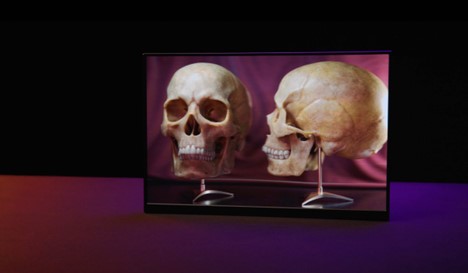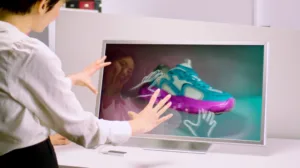With all the work being done today in stereo 3D, many creators and end users are still examining the imagery on regular 2D flat-screens or have to wear headsets to see in three dimensions. Reflecting on that issue, Looking Glass set out to build a hologram company to provide a more immersive visualization experience, and since its founding a decade ago, has been working to improve the stereo 3D viewing experience by introducing a range of spatial displays.
Looking Glass uses proprietary light field technology to produce 3D scenes for multiple viewers, without requiring headsets. Looking Glass launched its initial product, the first desktop holographic development kit, in 2018. Two years later, the company released the first personal holographic display. In 2022, it went big with a 65-inch holographic display and the release of the Looking Glass Blocks platform for sharing holograms on the Internet. In 2023, debuted another device, Looking Glass Go, a portable holographic display that turns 2D photos into 3D scenes and can run holographic apps.
And now, the Looking Glass is offering a new generation of XR displays. It has just announced a 32-inch spatial display that joins a 16-inch super-thin spatial OLED display in this next-gen group of sleeker, more adaptable versions. The displays are tuned for XR developers and for professionals creating, presenting, and interacting with 3D digital images, video, and applications in real time, including designers, engineers, educators, researchers, and healthcare workers.
The two next-gen devices, which come in landscape or portrait orientation, can be mounted on walls or stand upright on a desk. They generate up to 100 views of a single 3D scene, allowing for seamless 3D visuals for groups than is accessible from other 3D hardware, according to Looking Glass. Both the 16- and 32-inch versions support a range of sensors for touchless gesture control and interactivity. Each comes with software that includes plug-ins for Unity, Unreal, Blender, and WebXR; a 3D model importer; and an SDK for developing custom 3D/holographic content.

The 16-inch version, which had been released earlier, boasts a full 16-inch diagonal screen with a resolution of 3840×2160, a refresh rate of 60 Hz, and a color depth of more than 1 billion. It has a viewing zone of 150 degrees overall (53 degrees optimal), with a viewing distance starting at 1 foot. It has one HDMI or DP connection. The display, which the company says combines OLED color with true spatial depth at 4K resolution, carries an MSRP of $4,000 but is priced at $3,000 for a limited time.
The just-released 32-inch display runs on a 64-bit Windows 10 operating system and has an input resolution of 7680×4320 as well as a 53-degree viewing cone that can accommodate 45–100 views. According to the company, the system requirements vary based on the software, although the graphics card used must be able to output the display’s 7680×4320 resolution over a 2× DisplayPort. (The software developed at Looking Glass is optimized for the Nvidia RTX 3090 Turbo, which can be purchased as an add-on.)
The Looking Glass 32-inch spatial display comes with a desktop mount plate, power supply, Get Started guide, two DP cables (1.8m), USB 3.0A to B cable (1.8m), microfiber cleaning cloth, optional external computer with secondary 15.6-inch touchscreen for app control and wireless keyboard/mouse combo set, and optional hard carrying case made of custom molded aluminum.

Karen is editor in chief of JPR’s TechWatch and GraphicSpeak. Karen comes to JPR with years of diverse experience in the publishing industry, both in the mainstream and technical press. Before joining JPR, she spent 24 years at Computer Graphics World magazine, serving as editor in chief for the last 16 of those years, writing news and feature articles on topics spanning the areas of film, television-streaming, computer gaming, digital fine art, AR-VR-XR, and more.

